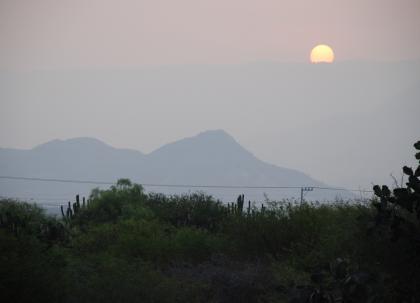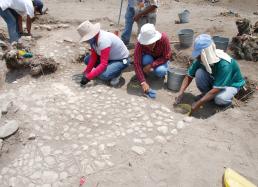3: Recollections and Collections
The twists of our lives are sometimes hard to predict and comprehend, just as trying to understand the course of past lives and histories is difficult for archaeologists to decipher. And yet, in both cases there are valuable lessons in looking back as the way forward is charted.
Thirty-six years ago, I made my first visit to the archaeological zone at Lambityeco, which hadn't opened that many years before. I was a young graduate student working with my professors on a regional, systematic, archaeological survey of the Valley of Oaxaca, a project from which I would draw data that was the foundation for my dissertation research.
We'd just arrived in the valley after a long, six-day drive from the mid-continental United States (the trip now takes less than four days), and my professors (Richard Blanton and Stephen Kowalewski) wisely reasoned that we could use a few days of sightseeing before tackling the many challenges of the foot survey.
They also knew that it would be practical to have us see (and hopefully begin to get the feel of) as many partially excavated and consolidated archaeological sites as possible, before trying to find and map such prehispanic locations, many of which had laid mostly dormant in fields and foothills for centuries (even far longer) when we traversed upon them.
Although at that time I knew that I wanted to continue investigating the prehispanic record of the Valley of Oaxaca for my research career, I didn't yet know that I would lead more than a decade and a half of excavations in the region.
Neither did I know that for much of my career, my prime temporal focus would be the Late Classic period (ca. AD 700-900) and the transition to the Postclassic period (ca. AD 900-1520) that followed—this is the time marked by the loss of regional dominance at Monte Albán and the restructuring of the region’s political landscape into smaller units that jockeyed for power (while repeatedly building and dissembling larger politico-economic networks) for the remainder of the pre-Spanish era.
Above all, I had no thought that I would someday lead excavations at Lambityeco. That was where John Paddock studied, and at the time, he and his collaborators were still immersed in their materials. Yet (and even more so over the years), I never had a doubt concerning the importance of Lambityeco as a key analytical piece for understanding the significant Classic-Postclassic changes in the region.
Why? The short answer is that even 36 years ago, it was clear that Lambityeco had some really key differences with Monte Albán at a time when the valley center still held great power (or very shortly thereafter). Years back, most thought the latter, but now radiocarbon assessments seem to indicate that the two sites overlapped in time for at least a good part of the period when these differences were noted.
What kind of differences? Paddock noted that the elite architecture and particular artifact assemblages at Lambityeco differed in certain key ways from Monte Albán. Whereas Monte Albán featured a huge Main Plaza surrounded by stone-faced platforms, the architecture at Lambityeco is more focused on elaborate residences and palaces (see Photo #1 below). There were such high-status residences at Monte Albán, but as far as we know, they tended to have one patio, while those at Lambityeco have at least two patios (see Photo #2 below.)
Carved stones and other representations at Lambityeco emphasized the familial lines of leaders in part to legitimize them. Such information was much less a part of the large carved stone corpus at Monte Albán, although a few late monuments conveying similar kinds of descent information have since come to light. The prime styles of figurines at the two sites also differ, as did the relative abundance of certain rarer ceramic variants, which tended to have relational connections to other regions of Mexico. Despite these differences, the basic styles of pottery and architecture were sufficiently similar to rule out ethnic change or differences between the sites.
If these changes at Lambityeco were at least in part contemporaneous with continued major occupation at Monte Albán, what precipitated these differences and what did they mean? How did political authorities legitimize and justify their positions and power, how and in what kinds of space did leaders conduct business, and what were the main kinds of domestic ritual in which ceramic figurines may have served a role? These are not trivial cultural matters that people just change reflexively; rather, they reflect fairly basic ideas about one’s identity, society, and relationship to community-level or societal authorities.
Over the intervening 36 years, we've learned that what was happening at Lambityeco was not unique to that site. At El Palmillo, Linda Nicholas and I noted many of the same differences with Monte Albán during the later Classic period, whereas some of the same patterns have been evidenced by an INAH team much closer to Monte Albán at the site of Atzompa.
It's becoming clear that the Classic-Postclassic transition in the region was not just the fall of Monte Albán or a breakdown into small polities, but was marked by key transitions in the nature of Zapotec rule and governance. Lambityeco was the first place where these Late Classic-period changes were clearly documented, and the extant record from the site makes it a very favorable place to study these shifts, which have been central to my research agenda for decades.
For this reason, it was a great pity that the tomb in Mound 165 was looted probably some months or years before we started research. Tombs of elaborate residences are key features to learn about rulers and their relations. For the most part, the artifacts from this feature are likely far away, somewhere on the global antiquities market (we did salvage a few pieces, such as a spindle whorl and an obsidian blade, by screening the disturbed sediments left by the pothunters).
But even more interesting were the corpus of human and other bone that we were able to sift from the dirt left behind. In this sediment, Keitlyn was able to record the bones of three children (two very young) and a young adult (possibly a woman). Thus, the use of this tomb appears not at all similar to the way that the tombs in Mound 195 at Lambityeco (where Paddock excavated) were employed. There, the heads of households (male and female) were principally interred in the palatial tombs (see Photo #3 below.)
We cannot rule out that the bones of adults were cleared from the tomb in our complex (Mound 165) during prehispanic times, yet we have no indications of that, either. We do know that from excavating around the tomb, it was entered, closed, and re-entered several times, which is standard practice for these Zapotec features.
At this point, what is clearest is that the funerary activity for Mound 165 was different from Paddock’s Mound 195. What this finding implies for other activities that went on in Mound 165 remains to be determined as we continue with the excavation and analysis (see Photo #4 below.)
More soon,
Gary







